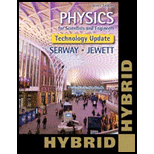
(a)
The quantity
(a)
Answer to Problem 11.6P
The quantity
Explanation of Solution
Given info: The vector
The formula to calculate the dot product of two vector is,
Here,
Substitute
Thus, the value of dot product of vectors is
The formula to calculate the magnitude of vector
Here,
Substitute
Thus, the value of magnitude of vector
The formula to calculate the magnitude of vector
Substitute
Thus, the value of magnitude of vector
The formula to calculate the angle between the vectors is,
Here,
Substitute
Conclusion:
Therefore, the quantity
(b)
The magnitude of the total
(b)
Answer to Problem 11.6P
The magnitude of the total angular momentum of the system of the system about the axle of the pulley is
Explanation of Solution
Given info: The mass of counterweight is
The formula to calculate the cross product of two vector is,
Substitute
Thus, the value of cross product of vectors is
The formula to calculate the magnitude of cross product of two vectors is
Here,
Substitute
Thus, the value of magnitude of
The formula to calculate the magnitude of vector
Here,
Substitute
Thus, the value of magnitude of vector
The formula to calculate the magnitude of vector
Substitute
Thus, the value of magnitude of vector
The formula to calculate the angle between the vectors is,
Here,
Substitute
Conclusion:
Therefore, the quantity
(c)
Whether the angle between the vectors is given buy part (a) or part (b).
(c)
Answer to Problem 11.6P
The angle between the vectors is given by part (a).
Explanation of Solution
Given info: The vector
From part (a), the value of the angle obtained is
The value of angle obtained in part (a) is,
Conclusion:
Therefore, the angle between the vectors is given by part (a).
Want to see more full solutions like this?
Chapter 11 Solutions
Physics for Scientists and Engineers, Technology Update, Hybrid Edition (with Enhanced WebAssign Multi-Term LOE Printed Access Card for Physics)
- An object is placed 24.1 cm to the left of a diverging lens (f = -6.51 cm). A concave mirror (f= 14.8 cm) is placed 30.2 cm to the right of the lens to form an image of the first image formed by the lens. Find the final image distance, measured relative to the mirror. (b) Is the final image real or virtual? (c) Is the final image upright or inverted with respect to the original object?arrow_forwardConcept Simulation 26.4 provides the option of exploring the ray diagram that applies to this problem. The distance between an object and its image formed by a diverging lens is 5.90 cm. The focal length of the lens is -2.60 cm. Find (a) the image distance and (b) the object distance.arrow_forwardPls help ASAParrow_forward
 Principles of Physics: A Calculus-Based TextPhysicsISBN:9781133104261Author:Raymond A. Serway, John W. JewettPublisher:Cengage Learning
Principles of Physics: A Calculus-Based TextPhysicsISBN:9781133104261Author:Raymond A. Serway, John W. JewettPublisher:Cengage Learning University Physics Volume 1PhysicsISBN:9781938168277Author:William Moebs, Samuel J. Ling, Jeff SannyPublisher:OpenStax - Rice University
University Physics Volume 1PhysicsISBN:9781938168277Author:William Moebs, Samuel J. Ling, Jeff SannyPublisher:OpenStax - Rice University Classical Dynamics of Particles and SystemsPhysicsISBN:9780534408961Author:Stephen T. Thornton, Jerry B. MarionPublisher:Cengage Learning
Classical Dynamics of Particles and SystemsPhysicsISBN:9780534408961Author:Stephen T. Thornton, Jerry B. MarionPublisher:Cengage Learning Physics for Scientists and Engineers: Foundations...PhysicsISBN:9781133939146Author:Katz, Debora M.Publisher:Cengage Learning
Physics for Scientists and Engineers: Foundations...PhysicsISBN:9781133939146Author:Katz, Debora M.Publisher:Cengage Learning Physics for Scientists and Engineers, Technology ...PhysicsISBN:9781305116399Author:Raymond A. Serway, John W. JewettPublisher:Cengage Learning
Physics for Scientists and Engineers, Technology ...PhysicsISBN:9781305116399Author:Raymond A. Serway, John W. JewettPublisher:Cengage Learning College PhysicsPhysicsISBN:9781305952300Author:Raymond A. Serway, Chris VuillePublisher:Cengage Learning
College PhysicsPhysicsISBN:9781305952300Author:Raymond A. Serway, Chris VuillePublisher:Cengage Learning





